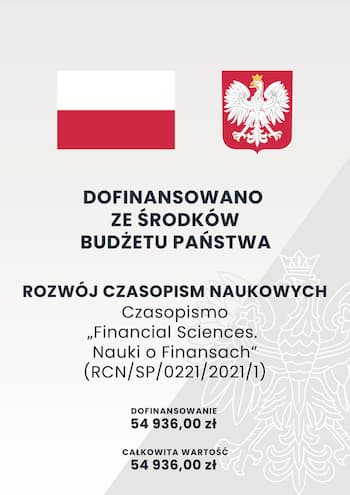Issues
Click a year to expand it.
40 Points
on Ministry of Education and Science journal evaluation list of 2024

Search results for query: Krysiak
Sort by: Relevance Author: Ascending Descending Year: Ascending Descending
- The Accuracy of the Equity’s Forecast in the Option Model Simulated by Real Volatility Distribution
Author: Zbigniew Krysiak
See Issue Contents: fins.2021.1
Abstract:The presented article is devoted to the assessment of the accuracy of the binomial model, also known as the option model, in forecasting the value of capital in a time horizon of up to 8 years using the Back-Test approach. In this study, the Monte Carlo method was used to simulate the value of capital using real volatility distributions of stock returns. Based on the analysis of the variability of stocks returns profile, a generator of real distributions was built, which was used for the Monte Carlo simulation. Studies of this type to a limited ex-tent are rare, and studies in full scope, as presented in the methodology presented in the ar-ticle, are unlikely to be performed. The results of the study confirmed the high quality and accuracy of the method proposed by the author. The methodology presented in the article ensures high accuracy in the medium term from 4 to 6 years. The average accuracy of the model is obtained in the horizon for 3 and 7 years, low accuracy was obtained for the hori-zon of 8 years and very low for the short horizon of 1 to 2 years. In 80% of cases, the capi-tal value is overestimated by + 23.4% or underestimated by -16.2%. Accurate capital esti-mation is observed in 20% of cases, which means that the market value coincides with the forecast in the model. The average estimation error is at the level of + 7.2%, which seems to be very attractive for practical applications, since the forecast deviating only by 7.2% from the market value gives investors and company’s management boards a very good tool supporting decision-making processes. Due to the potentially large benefits for company’s managers and investors that come from the measurement quality, according to the method-ology presented in the study, it is worth extending this trend in theory and practice.
- Should We Assume the Discount Rate to Be One of the Risk Factors
Author: Jan Kaczmarzyk
See Issue Contents: fins.2023.2
Abstract:Financial models implemented in corporate finance mostly rely on the discounted cash flow valuation approach. The basic concepts behind various forms of a discounted cash flow valuation are the present value of an asset and the net present value of an asset. Both concepts use a discount rate as a required rate of return for investors or broadly investors and lenders together depending on a particular analytical situation and the type of free cash flow stream. The Monte Carlo simulation is the ultimate solution for considering nearly all possible scenarios in presumably any discounted cash flow valuation. The Author of this paper argues that a discount rate expresses an investor’s cur-rent requirement and should be respectively perceived as a parameter only. The consequences of qualifying a required rate of return (a discount rate) as a risk factor in a dis-counted cash flow valuation are depicted in the paper using a free cash flow financial model of an asset being a hypothetical publicly traded enterprise. The case study is a discounted cash flow valuation using the Monte Carlo simulation for risk analysis. The various sets of assumptions are considered to explain the consequences of qualifying a required rate of return in a discounted cash flow model as a risk factor. As has been in-dicated in the paper, the discount rate as an additional risk factor with an attributed probability distribution increases the volatility of a risk variable. The distribution of a risk variable becomes more flattened then. In previous studies, some Authors indicated that a discount rate could be considered a risk factor in the Monte Carlo simulation (Krysiak 2000, Damodaran 2018).
- Risks in the investment activity of Polish regions
Author: Beata Zofia Filipiak, Marek Dylewski
See Issue Contents: fins.2018.4
Abstract:Investment activities executed by regional authorities are exposed to high risk. The risk results from the very essence of investment projects implemented by regions in Poland and can be associated with the failure to meet the regional budget. The purpose of this study is to assess the size of the existing discrepancies between the planned and actually incurred investment expenditure and to find out if there are systematic changes in the level of these discrepancies i subsequent years. This goal was achieved through the presentation of the specific approach to risk measurement in the investment activities of local government units. The research was undertaken by regional self-government units. Empirical research has allowed us to answer three research questions: how great were the disparities between the planned and the actually incurred investment costs in the Polish regions in 2011-2015? Did systematic changes in the level of inconsistency between the planned and the actually incurred costs take place in the observed period? Was the rate of failure to meet investment plans correlated with the rate of failure to meet operational financial plans?
Newsletter






